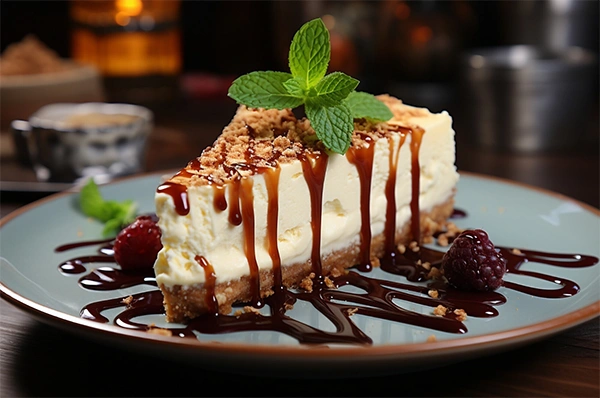

Top Health Benefits of Cheesecake with caramel sauce You Need to Know
This classic cheesecake with caramel sauce is a decadent dessert that offers a rich combination of flavors and textures. The cream cheese used in the filling is an excellent source of calcium, which supports bone health, and provides a good amount of protein to help in muscle repair and growth. The whipped cream adds a smooth, creamy texture, while the caramel sauce brings a burst of sweetness, rich in antioxidants from the sugar and butter. Additionally, the digestive biscuits used for the base are a source of carbohydrates, providing a quick energy boost. While delicious, this dessert is calorie-dense due to its fat and sugar content, making it a treat best enjoyed in moderation. Despite being high in calories, the combination of ingredients like cream cheese and butter can help maintain energy levels and give a satisfying feeling of fullness, making it ideal for occasional indulgence.
Recipe :
For 6 people
Enjoy your delicious homemade cheesecake!
When making this cheesecake, it is essential to follow the steps carefully to ensure the right texture and flavor. First, when preparing the biscuit base, make sure the butter is completely melted before mixing it with the crushed biscuits; this ensures the base will firm up properly when chilled. It's important to press the mixture into the pan firmly to prevent it from crumbling later. For the cheese layer, beat the cream cheese thoroughly to avoid lumps, and make sure the gelatin is completely dissolved in the cold water before heating it, as undissolved gelatin can cause an uneven texture. Refrigeration is a crucial step in allowing the cheesecake to set and hold its shape, so be sure to leave it in the fridge for at least 4 hours, if not overnight. The caramel sauce should be cooled slightly before being poured over the cheesecake to prevent it from melting the top layer. Always slice with a warm knife for clean edges and to maintain the aesthetic appearance.

This cheesecake is not suitable for several common dietary preferences or restrictions. It is not appropriate for those following a ketogenic diet due to its high sugar and carbohydrate content, especially from the biscuits and caramel sauce. For those on a vegan or vegetarian diet, this dessert is not suitable unless substitutions are made, as it contains dairy products like cream cheese and whipped cream. While it is compatible with a vegetarian diet (if dairy is acceptable), it is not suitable for those following a paleo diet, which eliminates processed foods like biscuits and sugar. The dessert is also not appropriate for individuals on a gluten-free diet unless a gluten-free biscuit alternative is used. Those on a low-calorie or weight-loss regimen should be cautious of the calorie content, as this dessert is calorie-dense. It can be enjoyed occasionally on the DASH diet, though the high sugar and fat content may need to be moderated. Overall, this cheesecake is a treat best suited for those who do not have dietary restrictions concerning dairy, gluten, or sugar.
...